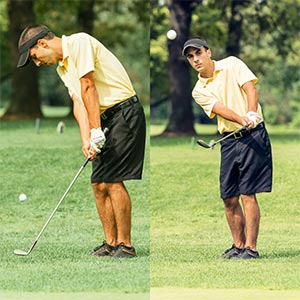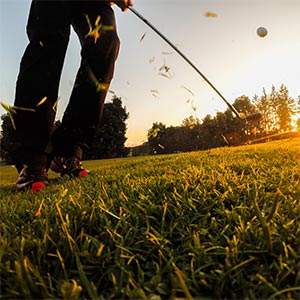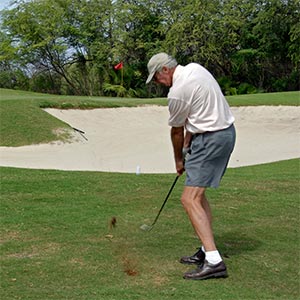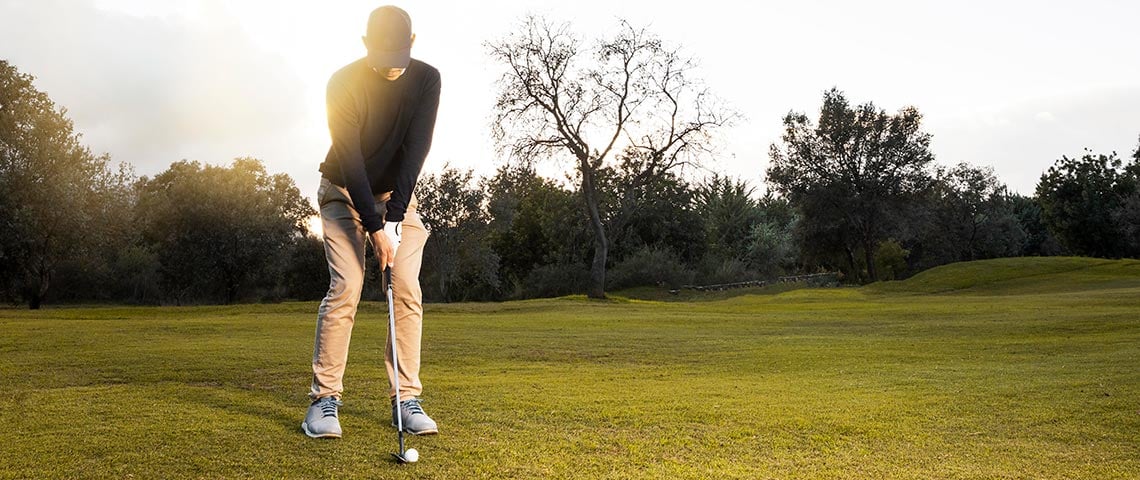The No Nonsense Guide To Chipping
Introduction: What is Chipping and How Does it Help with Your Game?

Chipping is a technique that help golfers get the ball closer to the hole with less effort. In turn, saving you strokes on the course. It involves using a short, controlled swing to hit the ball in a low trajectory, making it easier to control and land on the green.
Get the Right Equipment & Understand Basic Mechanics of Chipping
To master chipping, the right equipment is required. Understanding the fundamentals of chipping is important for golfers to ensure they can accurately control their chip shot distance.
Having the right golf chipper club and wedges can make a huge difference in your game. Choosing a golf club that matches your skill level and playing style is essential. Additionally, understanding how different clubs can affect your chip shot distance control will help you become a better chipper.
Posture

Proper posture is achieved by bending forward from the hips, allowing the arms to hang directly below the shoulders. This creates a space that effectively pre-sets the path for the arms and club to swing. Note, many golfers get into a squat-like posture, leading to inconsistent contact.
Good posture is the foundation for the perfect chip shot; from there, one can adjust their stance accordingly.
Stance
Putting and chipping strokes have some similarities. Both requiring little movement of the club. Additionally, your posture when carrying out either one, will essentially be the same.
Making slight modifications to posture and setup, helps in maximizing performance.
Optimal posture and stance will result in better contact being made.
Understand ball-turf interaction
If you want to hit a chip shot correctly, make sure the ball gets some lift in the air. For this, take into account the golden rule: Keep your club down to force an upward movement of the ball. Having a grasp on this concept, will assist you to make the right swing. This is why maintaining an upper body angle towards the target is vital - it will assist you to hit with a downward trajectory.
Chipping Stroke

Consistent form is key for a successful chipping stroke. Have arms and shoulders remain in a triangular position throughout the stroke. This will help keep arms and shoulders still, to maintain an even motion.
The size of the stroke differs from one person to another and is dependent on the distance of the shot. Ideally, below hip level and roughly consistent both during the backswing and follow-through. Avoid making huge chipping strokes, as they tend to negatively affect contact with the ball.
Develop Feel
There is no standard “one-size-fits-all” technique with chipping. Basically, it boils down to personal preference.
Tension can be detrimental to a golfers' performance. It can hinder their ability to sense the clubhead and the natural flow of movement when making contact with the ball. So, when gripping the club, wrists should relaxed just enough to move subtly during the stroke, resulting in the club falling softly to the ground.
Ball Position
The ideal stance is rather constrained with shorter chips. The ball is positioned slightly behind. Options to make adjustments are limited; however, simply adjusting the ball position changes the shot height.
Optimal ball position is essential to make the most out of your swing. By positioning the ball slightly forward, you’ll be able to launch the ball higher with less shaft lean at set-up. Placing the ball further back, will cause a lower trajectory and create more spin. Use this as a guide to adjust according to your shot and individual preferences.
Distance Control
Once you have a good grasp of the fundamentals, you move on to distance control.
When it comes to calibrating your distances, there are various ways you can do this. Personally, I prefer to first get used to one particular stroke size and swap clubs using the same stroke size, which changes flight-to-roll ratio and subsequently the distance.
Practice
Testing your chipping setup is essential and can be done easily by setting an alignment rod near the ball. If it moves from in-to-out, it means that you are taking a wide stroke which can result in a shank.
Pick A Target
Knowing the flight-to-roll ratio when chipping is advantageous. This means, assessing if your ball flies a 3rd of the distance and rolls 2/3rds or vice versa.
To get a better understanding, try placing a golf club or tee a 3rd of the way between the hole and your golf ball. Aim to have your ball land on it and observe how far it rolls afterward. If it successfully lands on the tee but fails to reach the hole, switch clubs.
Driving Range Practice and Warming Up

To perform your best on the golf course, take some time beforehand to practice chipping and pitching.
Spending some time on the driving range prior to playing on the course, can be potentially beneficial. It's gonna build confidence and give you the feeling of making good contact.
Being an excellent chipper is one of the quickest ways to reduce your scores. You don't need a robust and powerful golf swing to be great at it; all you need is practice, dedication, and the right techniques.
When you become a proficient chipper and find yourself having missed the green, you should remain confident in your ability to make up for it.
When you become a proficient chipper, you can alleviate the burden on your putting game by getting closer to the hole.
This skill can effectively level the playing field, at the same time lower your score. At the end of the day, the goal is to have more fun.

